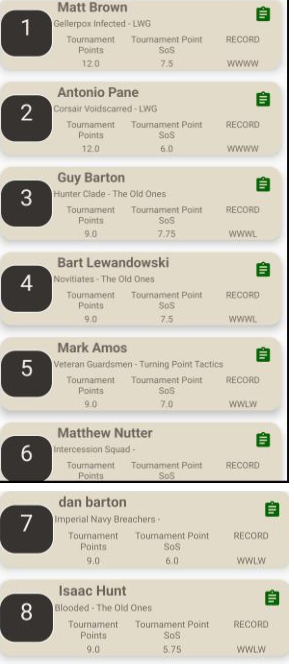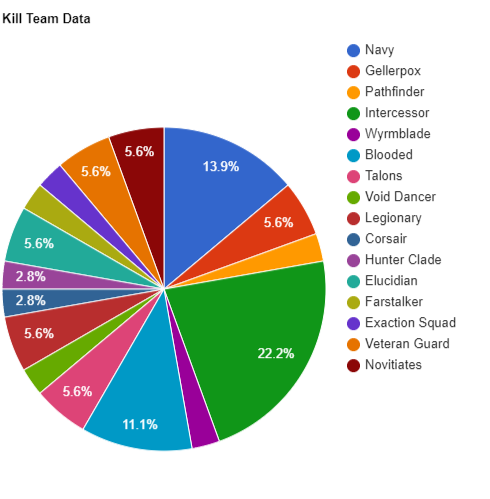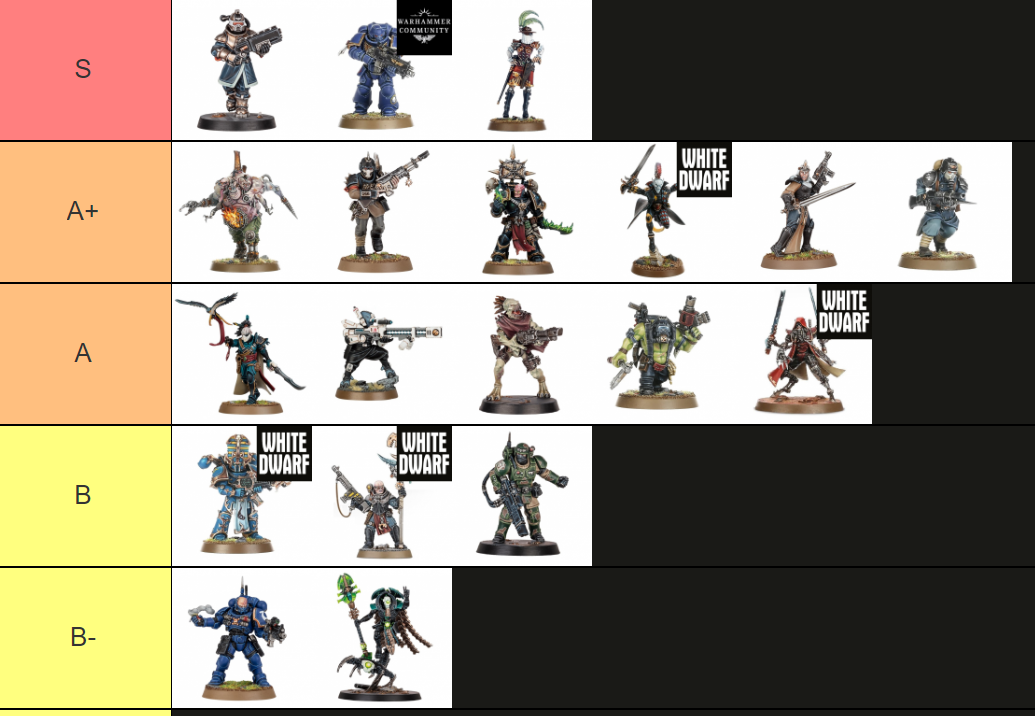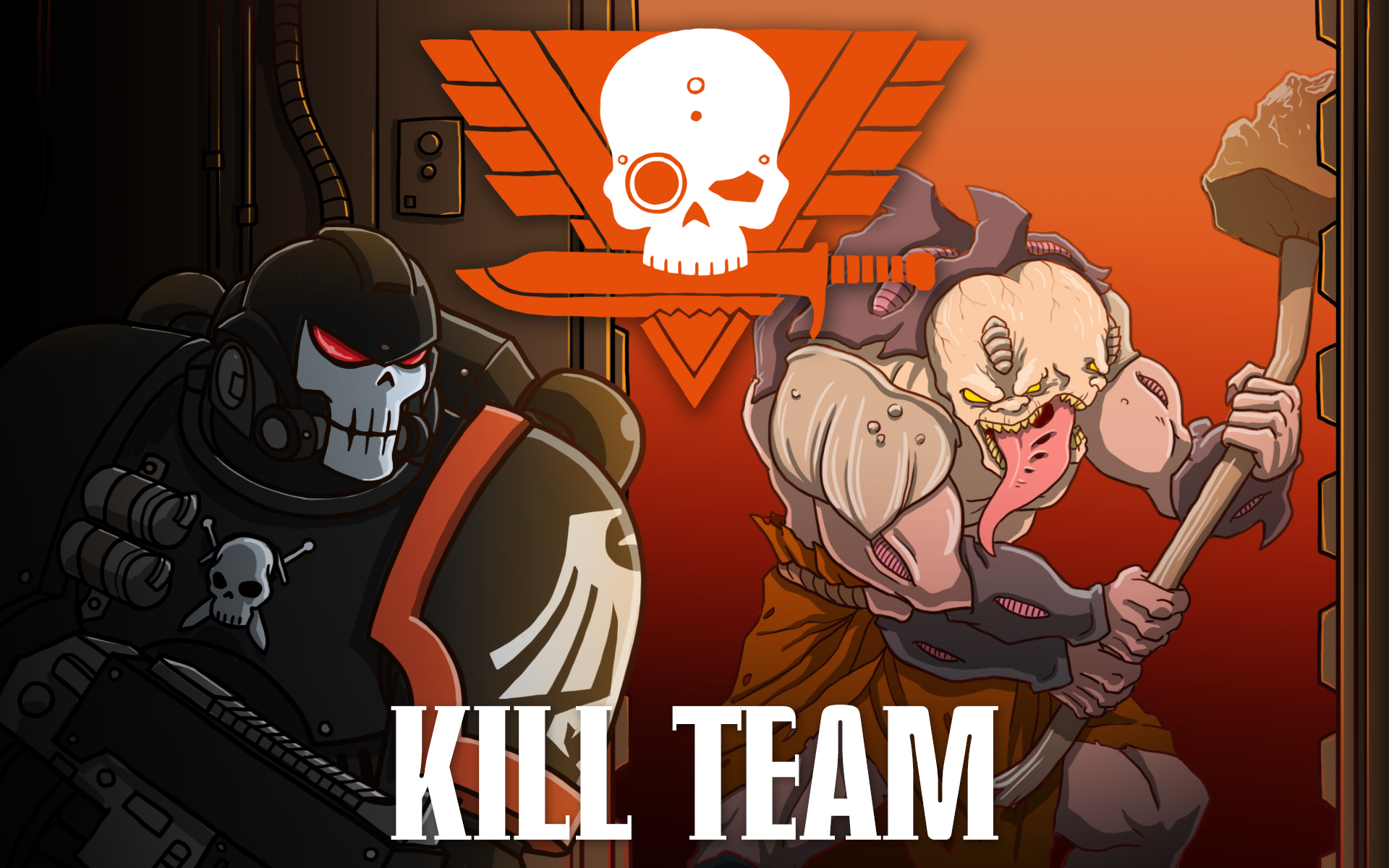Attention Troopers: Officer on deck! We are locked and loaded and ready to talk about important business. We’re nearly three months into 2023 and so today we’re talking about the Kill Team meta, analyzing all the big tournament data we can get our hands on, and building our own TIER LIST.
That said, this isn’t just going to be about the Tier List and meta – we’ll also be reflecting a bit on these concepts and what they mean. So bundle up on your favorite sofa or lounge chair, get comfortable, and enjoy. Our dataset today includes every major tournament we’ve got data on since January.
How important is “The Meta” and how does it affect me?
Let’s start by understanding what the meta is: Short for “the Metagame,” the Meta refers to the game outside the game. In the context of Kill Team refers to the way players choose which teams to play based on things like the terrain layout at an event or what other teams they expect to play against. There’s a whole game you can play around which team to pick if you think you’ll have to play more missions in the Gallowdark, or against melee teams. That’s the metagame.
However it’s also important to note that The Meta is also a construct created by competitive players; in this game you can win with almost any Kill team regardless of its position in a tier list. Your path may be easier or harder depending on what team you pick and the circumstances, but you’ll almost always be better off playing a disadvantaged team you know – one with which you are comfortable – than a stronger team you have no experience with.
That said, it’s always fun to speculate about which Kill teams are working in which regions.
So how does this affect you as an individual? Well, mostly by helping you understand which teams are facing an uphill battle and which teams have an easier time of things, and also helping understand how things might change when the next balance update hits. When Games Workshop works on game balance, they tend to use win rates to see which factions are doing well or poorly, and if you’re playing a faction at either the top or bottom end, your faction can be affected by balance updates.
The Problem with Win Rates
Win rates can be a useful tool for helping us understand how a team is doing competitively but they’re far from the only tool we should be using. There are a few things we need to be mindful of when we look at win rates in Kill Team:
- Our sample sizes are very small. Competitive Kill Team is growing, but still small compared to Age of Sigmar and 40k. We have data on about 6,000 games per quarter, which means that many teams just don’t get enough representation and a small number of players or games can have a dramatic impact on a faction’s win rates.
- As a result, player selection biases the sample. Good players play factions that they consider good. This boosts the win rate of those factions, which in turn leads players to think they’re good, and more good players adopt the faction. Inversely, the opposite is true for bad factions. And because kill team is a game where skill matters more than team selection, this can make win rates a poor way of gauging the strength of factions.
- The Surprise factor. Players tend to lose more games against factions they haven’t played against before, so less common teams can have an advantage, particularly at middle tables where players may not have the practice playing against every faction.
- Rookie or inexperienced players tend to play simple factions, or the factions they already own. Let’s call this The Intercessor Effect (or Legionnaire, if you prefer). There are several factions which are recommended for new players across multiple content creator channels (and rightly so), and these are often teams which consist of models 40k players will already have lying around, with no extra purchase required. These factions end up having a disproportionately large representation in competitive events, particularly from newer players, which depresses their win rates.
- Environmental Effects. This isn’t just about playing in Open (standard) or Closed (Gallowdark) terrain (though those matter a lot), but also each region and country will have its own things to think about in terms of terrain, player style, and faction choices. An environment full of elite teams will favor taking Pathfinders while an environment with lots of Hunter Clades and Gallowdark setups will not.
All of this means that win rates are unreliable as a tool for balancing the game. And now that we’ve established that I’ll step off my soapbox and we can move on to the meta analysis – but one that will be framed in different terms. I’m going to look at several big tournaments held around the world during the past three months to look at possible differences and faction representation.
The Sample
We’ll start with a general sample of the last three months of GT+ events and remove Compendium teams from the mix. And yes, we’ll look at win rates here to start:

Credit: HotSauceTeddy
Elucidian Starstriders and Gellerpox are the real winners of these first three months. They’re both newer factions which are full of tricks (helpful for the surprise factor), and both have definitely advantages: Starstriders have 3+ artillery which can catch players off guard and dictate the game, while Gellerpox can make it incredibly difficult to concentrate on scoring with four huge monsters on the table.
On the other side we have the Phobos and Necron teams which undoubtedly need some kind of help. Phobos likely need something to make them more reliable in shooting, while Hierotek Circles desperately need a rework to their resurrection mechanics.
Diving Into the Events
First – and because they are the most recent events – let’s take a look at the two biggest events in Spain: Campanas De La Plaga, a 66-player, 7-round Major in Torredembarra last weekend, and Nacional De Valencia 2023, a 46-player, 7-round Major in Chirivella, on February 18th.
Intercessors and Imperial Navy teams are the only repeats in the Top 8s, and there’s plenty of diversity otherwise – Farstalker Kinband, Veteran Guardsmen, Elucidian Starstriders, Novitiates, Kommandos, and the new Exaction squad all make appearances. That’s a total of 8 different factions across two majors and with mixed terrain and that’s a good sign – it indicates a relatively diverse and healthy meta where some of us are no longer surprised by the rise of Intercessors as the elite faction preferred by competitive players.
Heading over to England, let’s take a look at the LWG Season 1 event, which had 36 players and was the country’s biggest event this year, taking place entirely on closed/Gallowdark terrain:

Intercessors and Imperial Navy both make strong showings, but we have six more factions represented here: Blooded, Veteran Guardsmen, Novitiates, Hunter Clade, Corsair Voidscarred, and Gellerpox. Another good mix to consider.
And speaking of fully Into the Dark events we have the Kill Team Open champs event, the largest non-LVO US event, an 87-player, 8-round major which took place in Maryland on February 19th.
Another interesting mix, with two Talons of the Emperor teams, Void Dancers, Intercessors, Legionnaires, Navy Breachers, and two Blooded teams. Again, a healthy mix that offers more variety.
And then finally we have the LVO 2023 Championships, an 87-player, 7-round event that took place in Las Vegas on January 28th. In contrast to our last two events, this event featured only Open terrain, so players did not have to build for or worry about Gallowdark play:

This event gives us two Imperial Navy, Gellerpox, Pathfinders, two Intercessors, one Wrymblade, and one Blooded team in our top 8. So again a solid mix, with 6 unique teams in the top 8, but some repeats of prior events that help us develop a picture of what the top teams may be.
The distinction in terrain is also helpful, as we can see a different set of teams make the cut based on the different style of terrain in US events.
What Does it Mean: Analyzing the Data
So what does the data tell us about team representation at these large events? Keep in mind that this is a small sample, but we have enough common factors to start making some observations.

Our sample of five GTs gives us top 8 showings for 15 out of the 21 non-Compendium teams. There’s some over-representation here: The numbers for Imperial Navy and Intercessor teams stand out most glaringly, and Blooded ended up with three top 8 showings while all other factions capped out at 1-2.
Competitively I find this data to be much more interesting than using global win rates; these results both show the diversity of “viable” factions while also showing what the field are likely to take to an event. And while it’s difficult to determine player skill by region – especially for an event like LVO which has international pull – this seems like a much more reliable approach to determining the top/bottom factions than just using broad win rates.
This also helps us understand where some of our win rates come from: A pair of event wins for Gellerpox – 4-0 at LWG and 7-0-1 at LVO – have an outsized impact on the faction’s win rate given the team itself is relatively rare in terms of representation at events. In a game based more on skill than list selection it’s unlikely that Gellerpox in their current form are a problem, especially as top players don’t seem to be gravitating to the faction. On the other hand, it comparatively takes much more to move the needle for Intercessors and Breachers and while the former have a more pedestrian win rate, the latter’s high win rates and representation at top events make them more a faction to watch.
On the whole, the current Kill Team meta is very healthy, with solid balance that leads to 13-15 out of 21 factions currently showing competitive strength.
The Tier List
The meta is still in a healthy place and with smaller events and fewer rounds the chances you can take whatever faction you want and use it to win events in your area increases. That said, if you want to qualify in the top 8 of a major, you’ll likely have to go the extra mile and prepare for each matchup – your skill and knowledge of the game and the opposing faction are going to be what powers you over opponents more often than the power of the faction you chose to play.
And I can’t leave without leaving my own tier list here based on my absolute opinion based on my national meta and experiences:

I think the S tier is self explanatory; Navy and intercessors are the best and most versatile Kill teams in the game with very few (or no bad) matchups. Elucidian Starstriders enjoy the surprise effect and have many tools to deal with almost everything (although they suffer against MEQ).
The A+ and A tiers cover the majority of the game’s non-Compendium factions and most of these have been in a top 8 recently. Winning with these factions is very possible.
In the B Tier we have factions which haven’t seen top 8 finishes but are close to being able to make it. They may need a little help and have problems in too many matchups to consistently win without a discrepancy in player skill to overcome the faction differences.
Finally there’s the B- Tier. These factions need help badly and hopefully will get it in the next competitive dataslate.
This is a very healthy meta and the limits and differences between each tier are smaller than you’d think and often difficult to quantify. This makes the game as exciting as ever and one where player skill matters significantly more than faction selection. That’s ideal for any game and the differences in terrain also help to mix things up from event to event.
Have any questions or feedback? Drop us a note in the comments below or email us at contact@goonhammer.com.





